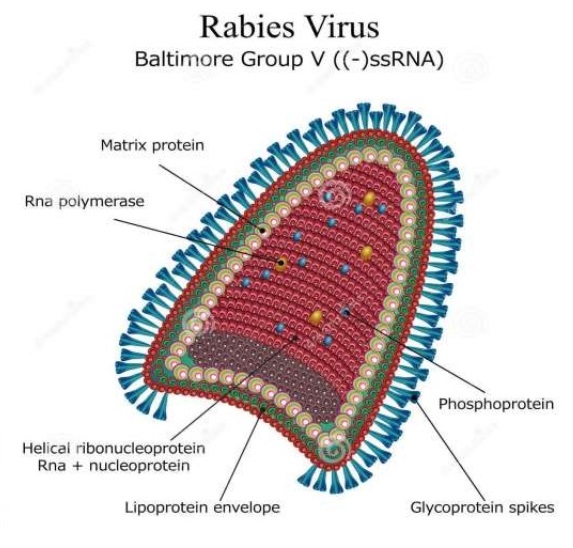Rabies Virus : Rhabdoviruses
Describe the morphology of rabies virus. Describe the pathogenesis, laboratory diagnosis and prophylaxis of rabies.
Definition
Causative organism (virus) for Rabies
Incubation period:1-2 monts from less than 10 days to 2 yrs
Morphology
Rod or bullet shaped
Single stranded
Negative-sense - (Positive sense RNA can produce proteins directly; Negative sense RNA cannot produce proteins drectly)
Unsegmented
Enveloped RNA virus
The virus genome encodes five proteins
Genus Lyssavirus
Multiplication
Viral RNA uncoats in the cytoplasm of infected cells. The genome is transcribed by a virion-associated RNA-dependent RNA polymerase. The viral RNA is translated into individual viral proteins. Replication occurs with synthesis of positive-stranded RNA templates for the production of progeny negative-stranded RNA
Pathogenesis
After inoculation the virus may enter the peripheral nervous system directly and migrates to the brain or may replicate in muscle tissue, remaining sequestrered at or near the entry site during incubaton, prior to central nervous system invasion and replication. then spreads centrifugally to numerous other rgans.
Laboratory Diagnosis
Unvaccinated persons are often negative for virus-neutralizing antibodies until late in the course of disease.
Diagnosis is by : a) Antigen detection by specific immunofluorescence or b) by ELISA specific antibody detection
1. virus isolation from saliva (by inoculating saliva into neuroblastoma cells or lab rodents; most successful during the first 2 to3 weeks of illness),
2.Positive immunofluorescent skin biopsies (skin biopsy from the nape of the neck) or
3. Virus neutralizing antibody (from CSF, or serum of a non-vaccinated patient, ( Human rabies immune globulin : HRIG, Human diploid cell vaccine:HDCV; rabies vaccine adsorbed:RVA)
Postexposure treatment will abort the infection but there is no cure for clinical disease.
Control
vaccination of susceptible animal species, particularly dogs and cats, will control this zoonotic disease
Preexposure immunization of veterinarians, animal handlers, certain lab workers.
Antirabies vaccine - may be given after the infection has occurred but before the disease manifests.
The vaccine should never be administered in the gluteal area.
It is given along with antibodies (passive immunization) if it is given after the disease has manifests.
Probably antirabies vaccine is the only vaccine which is given after the infection has occurred and is effective also in preventing the disease.
Antirabies immunoglobulin (virus neutralizing antibody)
Epidemiology
Rabies known for over 4000 years
The virus usually occurs in carnivores such as foxes, coyotes and in insectivorous bats
95% of cases occurring in Africa and Asia.
99% of rabies cases are dog-mediated and the burden of disease is disproportionally borne by rural poor populations, with approximately half of cases attributable to children under 15.
India accounts for 59.9% of rabies deaths in Asia and 35% of deaths globally.
The global community aims to eliminate human deaths from dog mediated rabies by 2030.
* * * * * * *



